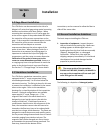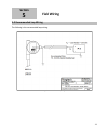
Section
3
Transmitter Description
3.0 Detailed Description
The LTM-Series is an assembly of two major
components:
The Sensor Tube Assembly: This is a 5/8” diameter
stainless steel probe, sealed on one end, with the
magnetostrictive waveguide in its center. In
addition to the magnetostrictive waveguide, the
tube also houses the optional temperature sensor
and the sensing elements. The tube is made to
lengths of 2-30ft. in rigid construction.
The Enclosure and Electronics: The extruded
aluminum housing has two compartments. The
enclosure is rated NEMA 4X and 7. One side
contains the microprocessor board assembly and
calibration push buttons. The other side contains
the field wiring termination board. The electronics
module is connected to the detector board of the
sensor tube assembly via a plug-in cable. The
electronics module houses printed circuit boards
(PCB) that encompass surface mount component
construction utilizing the latest integrated circuit
technology.
Magtech also has a stainless steel enclosure
that can be utilized. Please contact factory for
further details.
3.1 Technology – Theory of Operation
The LTM-250/350 series level transmitters are
based on the principle of magnetostriction, first
used for digital delay lines and later precision
distance or displacement in the machine tool
industry. This principle, if designed and applied
properly, has potentially very high measurement
resolution, typically better than 0.001 inch. In the
machine tool industry such a high resolution is
desirable. In the level measurement application,
however, a resolution of 0.03 inch is more than
adequate.
In a brief description, the magnetostrictive principle
consists of a wire extruded and heat treated under
carefully chosen conditions to retain desired
magnetic properties, which is pulsed by a circuit
with a relatively high current pulse. The high
current pulse produces a circular magnetic field as it
travels down the wire at the speed of sound.
Another magnetic field generated by a permanent
magnet (the float), placed near or around the wire
at some distance from the point of entry of this
pulse interferes with the magnetic field of the
current pulse and a torsional force results at the
collision point.
Figure 6. Principle of Operation
The effect of this torsion force is a twist to the wire
at this point producing torsion wave traveling
towards both ends of the wire. The propagation
time (or time-of-flight) of this wave is measured
precisely and if the wire properties remain stable, it
is very repeatable at about 5-10 microseconds per
inch, which is approximately the speed of sound in
that medium. By measuring the exact number of
microseconds it took the torsion wave to reach a
designated termination point of the wire, the
distance to the magnet from this termination point
can be easily calculated.
5


















